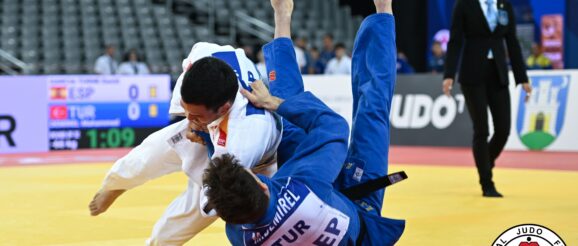Technical Analysis, Day 1: Education, Tradition and Innovation are the Best of Friends / IJF.org

“It’s been a while since I was present on the World Judo Tour, since my role means I focus on the European events. Firstly, it has changed a lot since I last stepped on the mat for competition, some 9 years ago. The rules, judogi and approach have all been updated. It’s nice to see the high level of organisation here, which is also moving forward all the time. It’s a motivation for athletes, coaches and referees to live up to the expectations of their environment. It’s also important for sponsors to see how we are, to see the professionalism, to fully understand that we continue to be worth investing in.
I have been really happy to see many former athletes who are still working in the sport, now in their different roles, maybe as coaches or officials. After such a break it is really nice to feel the spirit of the judo family; it’s positive and also different from how I remember it.
It was really great to be present at the referee briefing just prior to the event, to see and be part of such open discussion, sharing thoughts and ideas together. This is a really good change, a great addition to the event schedules. We all need to speak the same language even if with ten different dialects, to be able to understand each other. To have coaches there, such as Yvonne’s Boenisch, is also important. I have to thank Mr Vizer and Mr Lascau for giving everyone this new opportunity, a new chapter in our judo education.
Now thinking about the tournament itself, there were some huge throws and various nice ippon scores today, with really effective technique being employed. I’m now seeing the updated rules in action and Mr Lascau spent some time with me explaining some of these details, which was so useful and also very clear.
As a sport director I usually watch the broader view of competition but here, invited as a guest of both Croatian Judo and Mr Lascau, my focus is on the details, an education that I really value. I’m watching the really fine specific points of what makes ippon and what changes potentially maximum scores to waza-ari. I’m focussing on how to designate scores when two athletes are moving at high speed and there is a situation where perhaps both land on their side. It’s really important that everyone involved gets this right, as it makes a huge difference to the careers of these athletes.
We looked today at beautifully set up techniques, specifically uchi-mata or koshi-guruma but when we looked more closely we could still see so many dangerous actions with judoka losing control in the very end stage, leading to head-diving or possibly spiking an opponent into the mat. Everyone knows these rules but there is still much more work to be done to ensure safety is the priority.
Juji-gatame was a tokui-waza for me and I really like to see different variations of approach, it’s always interesting for me. Today though, I saw only one real way but they finished the technique very well and so maybe variation wasn’t needed among these athletes. It was interesting as I thought maybe I would see more styles; it was quite traditional here. It’s good to see that classical ne-waza is still present despite all the innovation, for many judoka. Judo will always be judo, even with evolution and modernism.”
Day one came to an end, thrilling both the online and arena spectators. Day 2 begins at 9am local time; tune in to watch on JudoTV.
